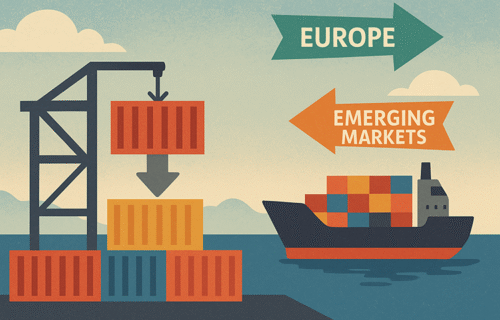China’s export engine lost momentum in October 2025, signalling renewed pressure on the world’s second-largest economy as global demand weakens and trade dynamics shift. Official customs data show that goods shipped abroad fell compared with the previous year — the first decline in several months — driven largely by a sharp drop in sales to the United States.
Exports to the U.S. dropped steeply in October, continuing a trend of reduced orders following months of tension and tariff adjustments. Analysts say this pullback now appears structural rather than temporary. At the same time, China increased shipments to regions such as Southeast Asia and Africa, though not enough to counterbalance the fall in U.S. demand.
The European Union remains China’s most significant trading partner, and new figures from Eurostat and the OECD show the depth of this reliance. Last year, the EU imported more than €500 billion worth of goods from China — far more than it exported in return — leaving Europe with a trade gap of more than €300 billion. Eurostat’s 2025 updates indicate that Europe’s purchases from China have stayed high even as Chinese exports slow elsewhere, underscoring how embedded China remains in European supply chains.
While the October decline appears modest on paper, it follows unusually strong results a year earlier, when China recorded one of its fastest export growth rates in over two years. Economists therefore caution against reading the slowdown as a collapse, pointing instead to a combination of high comparison levels, weaker orders from Western markets, and domestic strains — especially the country’s still-fragile housing sector and cautious consumer spending.
Trade tensions between Beijing and Washington eased slightly after recent negotiations reduced some shipping fees and delayed new tariffs. Investment banks expect this could support export volumes in 2026, though the effect may take months to emerge. Some forecasters, including those tracking Chinese trade on behalf of global investors, caution that a sustained recovery will depend on lower borrowing costs worldwide and on stability in shipping prices.
European trade researchers note that China is increasingly steering exports toward markets with fewer political frictions. However, they also highlight a growing risk for Europe: even as China’s exports show signs of fatigue, Europe’s dependence on Chinese goods — from electronics to industrial components — remains high.
The latest data suggests that China’s export sector is entering a period of transition rather than contraction. The country is selling less to the United States, maintaining strong volumes to Europe, and testing new ground in emerging regions. Whether this becomes a lasting realignment depends on how quickly global demand stabilises and whether Beijing succeeds in redirecting its trade influence toward new customers.
Source: EC, Eurostat, OECD and CIJ.World Analysis Team
